
The geometer moths are moths belonging to the family Geometridae of the insect order Lepidoptera, the moths and butterflies. Their scientific name derives from the Ancient Greek geo γεω, and metron μέτρον "measure" in reference to the way their larvae, or "inchworms", appear to "measure the earth" as they move along in a looping fashion. A very large family, it has around 23,000 species of moths described, and over 1400 species from six subfamilies indigenous to North America alone. A well-known member is the peppered moth, Biston betularia, which has been subject of numerous studies in population genetics. Several other geometer moths are notorious pests.

Ennominae is the largest subfamily of the geometer moth family (Geometridae) with some 9,700 described species in 1,100 genera. They are usually a fairly small moths, though some grow to be considerably large. This subfamily has a global distribution. It includes some species that are notorious defoliating pests. The subfamily was first described by Philogène Auguste Joseph Duponchel in 1845.

Geometrinae is the nominate subfamily of the geometer moth family (Geometridae). It is strongly split, containing a considerable number of tribes of which most are presently very small or monotypic. These small moths are often a light bluish green, leading to the common name of emerald moths, though a few species called thus are also found in the tribe Campaeini of the Ennominae. In 2018, a phylogeny and classification based on a molecular phylogenetic analysis was published in the Zoological Journal of the Linnean Society in which 13 tribes were accepted.

Larentiinae is a subfamily of moths containing roughly 5,800 species that occur mostly in the temperate regions of the world. They are generally considered a subfamily of the geometer moth family (Geometridae) and are divided into a few large or good-sized tribes, and numerous very small or even monotypic ones which might not always be valid. Well-known members are the "pug moths" of the Eupitheciini and the "carpets", mainly of the Cidariini and Xanthorhoini. The subfamily was described by Philogène Auguste Joseph Duponchel in 1845.
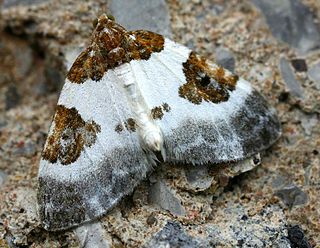
The Cidariini are the largest tribe of geometer moths in the subfamily Larentiinae. The Cidariini include many of the species known as "carpets" or, ambiguously, "carpet moths", and are among the few geometer moths that have been subject to fairly comprehensive cladistic study of their phylogeny. The tribe was described by Philogène Auguste Joseph Duponchel in 1845.

Aeolochroma metarhodata, the tea-tree emerald, is a moth of the family Geometridae first described by Francis Walker in 1863. It is found in the Australian states of Queensland, New South Wales, and Victoria.
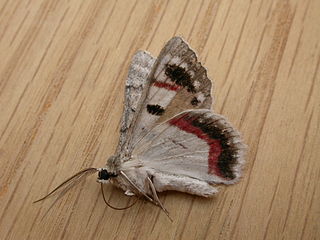
Crypsiphona ocultaria the red-lined looper moth or red-lined geometer, is a moth of the family Geometridae. The species was first described by Edward Donovan in 1805 and it is found in Australia.
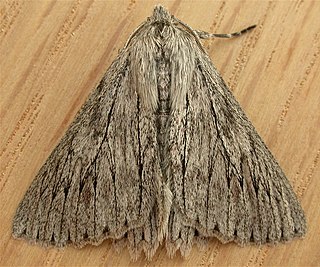
Cyneoterpna wilsoni, or Wilson's grey, is a moth of the family Geometridae first described by Rudolf Felder and Alois Friedrich Rogenhofer in 1875. It is found in the Australian states of Queensland, New South Wales, Victoria, South Australia and Tasmania.

Hypobapta diffundens, the diffundens grey, is a moth of the family Geometridae first described by Thomas Pennington Lucas in 1891. It is found in the Australian state of Queensland.

Hypodoxa muscosaria, the textured emerald, is a moth of the family Geometridae first described by Achille Guenée in 1857. It is found along the east coast of Australia.
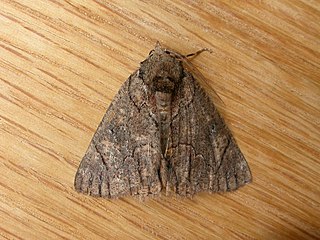
Heliomystis is a monotypic moth genus in the family Geometridae. Its only species, Heliomystis electrica, the electric moth, is found in the southern half of Australia. Both the genus and species were first described by Edward Meyrick in 1888.
Lophothorax is a monotypic moth genus in the family Geometridae. It consists of only one species, Lophothorax eremnopis, which is found in Australia. Both the genus and the species were first described by Alfred Jefferis Turner, the species in 1922 and the genus in 1939.

Sterrhinae is a large subfamily of geometer moths with some 3,000 described species, with more than half belonging to the taxonomically difficult, very diverse genera, Idaea and Scopula. This subfamily was described by Edward Meyrick in 1892. They are the most diverse in the tropics with the number of species decreasing with increasing latitude and elevation.
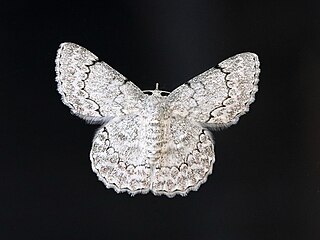
Pingasa chlora, the white looper moth or flower-eating caterpillar, is a species of moth of the family Geometridae first described by Caspar Stoll in 1782. It is found Sundaland, the Philippines, Sulawesi and from the Moluccas to Queensland, Australia.
Louis Beethoven Prout (1864–1943) was an English entomologist and musicologist.
William Warren was an English entomologist who specialised in Lepidoptera.
Hypodoxa bryophylla, the green looper moth, is a moth of the family Geometridae. The species was first described by Gilbert M. Goldfinch in 1929. It is found in the Australian states of Victoria, New South Wales and Queensland.
Hypodoxa deteriorata is a moth of the family Geometridae first described by Francis Walker in 1860. It is found in Australia, including New South Wales and Victoria.

Hypodoxa emiliaria is a moth of the family Geometridae first described by Achille Guenée in 1858. It is found in Australia, New Guinea and on the Solomon Islands.
Pingasa cinerea, the tan-spotted grey, is a moth of the family Geometridae. The species was first described by William Warren in 1894. It is found in the Australian states of New South Wales, Queensland, Tasmania and Victoria.













